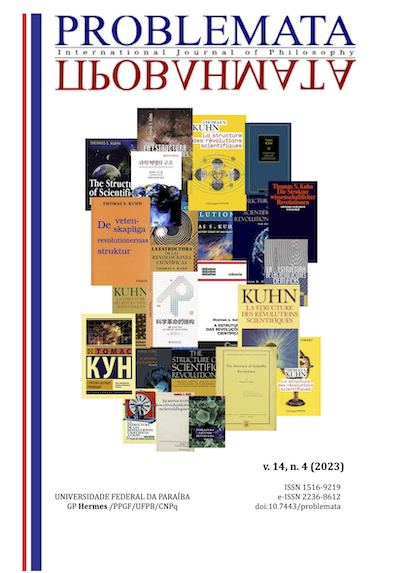INFORMATION THEORY IN THE 20th CENTURY:
DIALOGUES BETWEEN KUHN AND FLECK
DOI:
https://doi.org/10.7443/problemata.v14i4.65615Keywords:
Ludwik Fleck, Thomas Kuhn, history of physics, information theoryAbstract
This paper discusses how the work of the Polish microbiologist Ludwik Fleck contains answers to the longings and problems present in the work of Thomas Kuhn, particularly the notion of incommensurability between paradigms. We also discuss a possible role for Fleck's works in constructing a theoretical framework based on biology, as Kuhn longed for in his last writings. Finally, we illustrate the value of Fleckian epistemology by analysing the historical episode of the development of the information theory in different scientific communities during the first half of the twentieth century: Bell Laboratories and the cybernetics group in the United States of America and European group. Thus seeking conclusions about the role of Fleck's work in an epistemology of biological matrix, that is, one that follows an evolutionary model, and not a revolutionary one, of scientific making.
Downloads
References
CONDÉ, Mauro Lúcio Leitão Mutações no estilo de pensamento: Ludwik Fleck e o modelo biológico na historiografia da ciência. Revista de Filosofia Moderna e Contemporânea, 2018.
DELIZOICOV, Demétrio; NADIR, Castilho; CUTOLO, Luiz Roberto Agea; DA ROS, Marco Aurélio; LIMA, Armênio Matias Corrêa. Sociogênese do conhecimento e pesquisa em ensino: contribuições a partir do referencial fleckiano. Caderno Brasileiro de Ensino de Física, p. 52-69, 2002.
FLECK, Ludwik. To look, to see, to know. 1947 In: COHEN, Robert S.; SCHNELLE, Thomas (ed.). Cognition and fact: materials on Ludwik Fleck. Springer Science & Business Media, 2012.
FLECK, Ludwik. Gênese e desenvolvimento de um fato científico: introdução à doutrina do estilo de pensamento e do coletivo de pensamento. [S.l.]: Fabrefactum Editora, 2010.
GABOR, Dennis Theory of communication. Journal of the Institution of Electrical Engineers-Part III: radio and communication engineering, IET, v. 93, n. 26, p. 429-441, 1946.
HARTLEY, Ralph. Transmission of information 1. Bell System Technical Journal, Wiley Online Library, v. 7, n. 3, p. 535–563, 1928.
KUHN, Thomas. A estrutura das Revoluções Científicas. 7. ed. São Paulo: Editora Perspectiva, 2003.
KUHN, Thomas. Foreword. In: FLECK, L. Genesis and development of a scientific fact. Chicago: The University of Chicago, 1979.
KUHN, Thomas. The Road since Structure. Chicago: University of Chicago press, 2000.
NYQUIST, Harry. Certain factors affecting telegraph speed. New York: Transactions of the American Institute of Electrical Engineers - IEEE, p. 412-422, 1924.
OLIVEIRA, Bernardo Jefferson de. Os circuitos de Fleck e a questão da popularização da Ciência In: CONDÉ, Mauro Lúcio Leitão (ed.). Ludwik Fleck: estilos de pensamento na ciência. Belo Horizonte: Fino Traço Editora, 2012.
OTTE, George. Fato e pensamento em Ludwik Fleck e Walter Benjamin In: CONDÉ, Mauro Lúcio Leitão (ed.). Ludwik Fleck: estilos de pensamento na ciência. Belo Horizonte: Fino Traço Editora, 2012.
PENA, Aurélio Bianco; SILVA, Cibelle Celestino. Da comunicação à informação: quando a prática se sobrepõe à teoria. Revista Brasileira de Ensino de Física, v. 44, 2022.
PIERCE, John Robinson. An introduction to information theory: symbols, signals and noise. New York: Dover Publications, 1980.
SHANNON, Claude Elwood. A mathematical theory of communication. The Bell System Technical Journal, Nokia Bell Labs, v. 27, n. 3, p. 379-423, 1948.
WIENER, Norbert. Cybernetics: or control and communication in the animal and the machine. Cambridge, Massachusetts: MIT Press, 1948.
Downloads
Published
Issue
Section
License
Copyright (c) 2023 Aurélio Bianco Pena, Cibelle Celestino Silva

This work is licensed under a Creative Commons Attribution 4.0 International License.
Authors who publish with this journal agree to the following terms:
- Authors retain copyright and grant the journal right of first publication with the work simultaneously licensed under a Creative Commons Attribution License that allows others to share the work with an acknowledgement of the work's authorship and initial publication in this journal.
- Authors are able to enter into separate, additional contractual arrangements for the non-exclusive distribution of the journal's published version of the work (e.g., post it to an institutional repository or publish it in a book), with an acknowledgement of its initial publication in this journal.
-
- Authors are permitted and encouraged to post their work online (e.g., in institutional repositories or on their website) prior to and during the submission process, as it can lead to productive exchanges, as well as earlier and greater citation of published work (See The Effect of Open Access).





